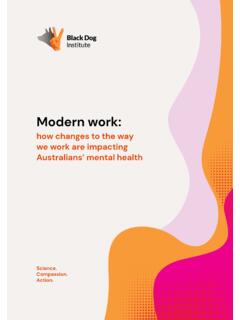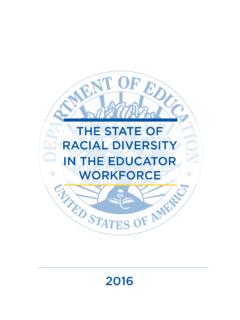Transcription of Deaf People & Educational Attainment White Paper
1 2017 National Deaf Center on Postsecondary OutcomesDeaf People and Educational Attainment in the United States: 2017 licensed under Creative Commons BY-NC-ND People and Educational Attainment in the United States: 2017 National Deaf Center on Postsecondary OutcomesCarrie Lou GarberoglioStephanie CawthonAdam Sales1 2017 National Deaf Center on Postsecondary OutcomesDeaf People and Educational Attainment in the United States: 2017 licensed under Creative Commons BY-NC-ND document was developed under a grant from the Department of Education, OSEP #HD326D160001. However, the contents do not necessarily represent the policy of the Department of Education, and you should not assume endorsement by the federal government. 2 2017 National Deaf Center on Postsecondary OutcomesDeaf People and Educational Attainment in the United States: 2017 licensed under Creative Commons BY-NC-ND this report, we use the term deaf in an all-encompassing manner to include individuals who identify as Deaf, hard of hearing, hearing impaired, late deafened, and education and training after high school is becoming increasingly important for successful independent living and employment in the United States.
2 Recognizing the great need for skilled employees who can meet the competitive demands of the modern workforce, current legislation and public policy are designed to facilitate conditions that support continuing education and training for all individuals. Legislation has also increased the accessibility of postsecondary education and training programs for deaf individuals, who are now enrolled in a wide variety of Educational programs across the United States. Current data on Educational Attainment for deaf People suggest areas of optimism, but also areas of concern. This report provides a comprehensive overview of the most current data on Educational Attainment trends and trajectories for deaf individuals in the United States, serving as a resource for community members, educators, researchers, and policymakers.
3 We used data from the 2015 American Community Survey (ACS), a national survey conducted by the Census Bureau. We limited our sample to individuals ages 25 64 to capture Educational Attainment data for individuals more likely to have completed postsecondary education and training. More information about this dataset and the analyses are shared in the Methods section at the end of this report. Key findings are summarized below. In general, deaf People attain lower levels of education than hearing People . 51% of deaf People complete at least some college. Younger deaf People are increasingly more likely to graduate from high school. General Educational Attainment rates have increased since 2008. Deafdisabled individuals demonstrate lower Educational Attainment levels. Deaf women attend college at higher rates than deaf men.
4 It is necessary to recognize how the intersectional identities of deaf People interact with Educational experiences and outcomes. Income and employment vary across fields of 2017 National Deaf Center on Postsecondary OutcomesDeaf People and Educational Attainment in the United States: 2017 licensed under Creative Commons BY-NC-ND Educational Attainment STATISTICSDEAFINDIVIDUALSHEARINGINDIVIDU ALSHIGH SCHOOLSOME COLLEGEBACHELOR S> BACHELOR S6% gap12% gap15% gap5% gap83%89%51%63%18%33%7%12%Overall, data show that deaf People attained lower levels of education than their hearing peers (see Figure 1). In 2015, 83% of deaf adults in the United States had successfully completed high school, compared to 89% of hearing adults, a gap of 6%. The gap in Educational Attainment between deaf and hearing People was the widest, at 15%, among individuals who had completed at least a bachelor s degree.
5 This is important because increasing levels of Educational Attainment narrows the employment gap between deaf and hearing individuals (Garberoglio, Cawthon, & Bond, 2016). Only 18% of deaf adults in the United States had completed a bachelor s degree or more, compared to 33% of hearing 1 Educational ATTAINMENTT here is evidence that Educational Attainment may be improving for younger People . Adults ages 25 34 have the highest rates of high school completion (see Figure 2). Deaf adults demonstrated a significant downward trend in high school completion across age, indicating that younger deaf People were more likely to complete high school. College completion is more variable between age groups for deaf individuals, with no clear demonstrated trends in college completion across age groups.
6 Educational Attainment gaps between deaf and hearing People appear to be roughly consistent across age 2017 National Deaf Center on Postsecondary OutcomesDeaf People and Educational Attainment in the United States: 2017 licensed under Creative Commons BY-NC-ND 2 Educational Attainment BY AGEHEARINGINDIVIDUALSDEAFINDIVIDUALSHIGH SCHOOLAGES 25 34 AGES 35 44 AGES 45 54 AGES 55 64 SOMECOLLEGEAGES 25 34 AGES 35 44 AGES 45 54 AGES 55 64 BACHELOR SAGES 25 34 AGES 35 44 AGES 45 54 AGES 55 64> BACHELOR SAGES 25 34 AGES 35 44 AGES 45 54 AGES 55 6490%86%88%84%88%82%89%82%67%52%65%54%61 %49%60%51%35%17%35%20%31%17%30%18%11%4%1 3%8%12%6%12%7%5 2017 National Deaf Center on Postsecondary OutcomesDeaf People and Educational Attainment in the United States: 2017 licensed under Creative Commons BY-NC-ND SCHOOLSOME COLLEGEBACHELOR S> BACHELOR SDEAF + NO ADDITIONAL DISABILITY88%56%23%8%DEAF + ANY ADDITIONAL DISABILITY76%44%12%4%DEAF + AMBULATORY DISABILITY74%41%9%4%DEAFBLIND72%40%11%4% DEAF + COGNITIVE DISABILITY72%38%9%3%DEAF + INDEPENDENT LIVING DIFFICULTY71%36%9%3% Educational Attainment AMONG DEAFDISABLED INDIVIDUALSF igure 3 Educational Attainment BY DISABILITYA large percentage of deaf individuals have an additional disability, each combination of which results in unique strengths and challenges.
7 Educational Attainment rates vary across type of disability (see Figure 3). On average, deaf individuals with any type of additional disability reported lower Educational Attainment levels. The lowest Educational Attainment levels were found amongst deaf individuals who were reported to have difficulties with living independently. In our analyses, we were limited to the disability categories that are used by the Census, which does not recognize group identity preferences or complex differences within broad disability categories. The Census focuses on functional abilities and does not attend to more complex issues surrounding identity, which is a limitation of this dataset. However, at a minimum, it is necessary to recognize that Educational experiences continue to be significantly more challenging for deafdisabled individuals.
8 HIGH SCHOOL COMPLETION DEAFDISABLED INDIVIDUALS76%COMPLETE24%INCOMPLETEDEAF INDIVIDUALS WITH NO ADDITIONAL DISABILITIES88%COMPLETE12%INCOMPLETE6 2017 National Deaf Center on Postsecondary OutcomesDeaf People and Educational Attainment in the United States: 2017 licensed under Creative Commons BY-NC-ND S> BACHELOR S83%88%82%90%50%59%54%67%17%31%20%35%6%1 1%8%13% Educational Attainment BY RACE, ETHNICITY, AND GENDERE ducational Attainment varies across gender, race, and ethnicity (see Figures 4 and 5). There are gender gaps in Educational Attainment in both groups; however, they occur at different stages. Hearing women are more likely than hearing men to graduate high school, whereas deaf women and men graduate high school at approximately the same rate. On the other hand, both deaf and hearing women are more likely than men to go to college, even if they do not receive a degree.
9 However, a closer look at the Educational Attainment gap between hearing and deaf People reveals that the gap is in most cases wider for women than for men. In other words, compared to deaf women, deaf men are completing high school, enrolling in college, and earning a bachelor s degree at rates closer to national averages for their 4 Educational Attainment BY GENDER7 2017 National Deaf Center on Postsecondary OutcomesDeaf People and Educational Attainment in the United States: 2017 licensed under Creative Commons BY-NC-ND Attainment varies wildly across race and ethnicity for hearing and deaf People . Among deaf and hearing People , White People were most likely to have completed at least a high school education and Asian People were more likely to have taken college classes or completed a college degree.
10 Educational Attainment disparities between deaf and hearing People of specific race and ethnicity groups varied between 1% and 27%. A closer look at Educational Attainment gaps across race and ethnicity reveals that the gap is larger for Asians than for all other race and ethnicity groups. For instance, 27% fewer deaf Asians than hearing Asians had completed at least a bachelor s degree. In other words, while an Educational Attainment advantage was present for deaf Asians, it was not as large as expected based on the Educational Attainment trends for hearing Asians. Figure 5 Educational Attainment BY RACE AND ETHNICITYSOME COLLEGEBACHELOR S> BACHELOR SHIGH SCHOOLSOME COLLEGEBACHELOR S> BACHELOR SHIGH SCHOOLSOME COLLEGEBACHELOR S> BACHELOR SHIGH SCHOOLHISPANIC/LATINOASIANAFRICAN AMERICANSOME COLLEGEBACHELOR S> BACHELOR SHIGH SCHOOLMULTI-RACIALSOME COLLEGEBACHELOR S> BACHELOR SHIGH SCHOOLWHITESOME COLLEGEBACHELOR S> BACHELOR SHIGH SCHOOLNATIVE AMERICANSOME COLLEGEBACHELOR S> BACHELOR SHIGH SCHOOLOTHERSOME COLLEGEBACHELOR S> BACHELOR SHIGH SCHOOLPACIFIC ISLANDER41%12%4%69%45%18%6%71%56%17%6%67 %63%35%12%86%54%20%7%87%69%37%14%94%52%1 1%6%84%54%16%3%91%53%13%5%81%51%15%5%85% 38%12%4%65%43%18%6%71%56%30%12%76%76%57% 25%90%42%11%4%76%57%22%8%88%HEARING INDIVIDUALSDEAF INDIVIDUALS8 2017 National Deaf Center on Postsecondary OutcomesDeaf People









